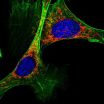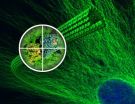(Press-News.org) Duke University researchers have found an antibody that simultaneously blocks the sensations of pain and itching in studies with mice.
The new antibody works by targeting the voltage-sensitive sodium channels in the cell membrane of neurons. The results appear online on May 22 in Cell.
Voltage-sensitive sodium channels control the flow of sodium ions through the neuron's membrane. These channels open and close by responding to the electric current or action potential of the cells. One particular type of sodium channel, called the Nav1.7 subtype, is responsible for sensing pain.
Mutations in the human gene encoding the Nav1.7 sodium channel can lead to either the inability to sense pain or pain hypersensitivity. Interestingly, these mutations do not affect other sensations such as touch or temperature. Hence, the Nav1.7 sodium channel might be a very specific target for treating pain disorders without perturbing the patients' ability to feel other sensations.
"Originally, I was interested in isolating these sodium channels from cells to study their structure," said Seok-Yong Lee, assistant professor of biochemistry in the Duke University Medical School and principal investigator of the study. He designed antibodies that would capture the sodium channels so that he could study them. "But then I thought, what if I could make an antibody that interferes with the channel function?"
The team first tested the antibody in cultured cells engineered to express the Nav1.7 sodium channel. They found that the antibody can bind to the channel and stabilize its closed state.
"The channel is off when it is closed," Lee explained. "Since the antibody stabilizes the closed state, the channel becomes less sensitive to pain." If this held true in live animals, then the animals would also be less sensitive to pain.
To test this idea, Lee sought the help of Ru-Rong Ji, professor of anesthesiology and neurobiology, who is an expert in the study of pain and itch sensation. Using laboratory mouse models of inflammatory and neuropathic pain, they showed that the antibody can target the Nav1.7 channel and reduce the pain sensation in these mice. More importantly, mice receiving the treatment did not show signs of physical dependence or enhanced tolerance toward the antibody.
"Pain and itch are distinct sensations, and pain is often known to suppress itch", said Ji.
The team found that the antibody can also relieve acute and chronic itch in mouse models, making them the first to discover the role of Nav1.7 in transmitting the itch sensation.
"Now we have a compound that can potentially treat both pain and itch at the same time," said Lee. Both of these symptoms are common in allergic contact dermatitis, which affects more than 10 million patients a year in the United States alone.
The team is pursuing a patent for the antibody.
"We hope our discovery will garner interest from pharmaceutical companies that can help us expand our studies into clinical trials," Lee said. Their goal is to develop a safer treatment for pain and itch as an alternative to opioids, which often cause addiction and other detrimental side effects.
INFORMATION:
The research was supported by NIH Director's New Innovator Award 1 DP2 OD008380-01 and grants R01DE17794, R01DE22743, and R01NS67686.
CITATION: "A monoclonal antibody that targets a Nav1.7 channel voltage sensor for pain and itch relief," Jun-Ho Lee, Chul-Kyu Park, Gang Chen, Qingjian Han, Rou-Gang Xie, Tong Liu, Ru-Rong Ju and Seok-Yong Lee. Cell, May 23, 2014.
One molecule to block both pain and itch
A new antibody appears to block 2 unpleasant nerve signals
2014-05-22
ELSE PRESS RELEASES FROM THIS DATE:
Deciphered the process through which cells optimize metabolism to burn sugars or fats
2014-05-22
To guarantee efficient use of nutrients, cells have systems that permit them to capture and transport the available nutrient molecules to their interior. But if several nutrients are available, cells can select those that are of most interest and discard undesired molecules.
Inside cells, nutrients are conducted to the mitochondria, the specialized cell organelles in which nutrients are combusted to release the energy held in their chemical bonds. Both sugars (glucose) and fats (fatty acids) are 'burned' in mitochondria, but these organelles need to adjust their molecular ...
New insight into stem cell development
2014-05-22
The world has great expectations that stem cell research one day will revolutionize medicine. But in order to exploit the potential of stem cells, we need to understand how their development is regulated. Now researchers from University of Southern Denmark offer new insight.
Stem cells are cells that are able to develop into different specialized cell types with specific functions in the body. In adult humans these cells play an important role in tissue regeneration. The potential to act as repair cells can be exploited for disease control of e.g. Parkinson's or diabetes, ...
Study: Some pancreatic cancer treatments may be going after the wrong targets
2014-05-22
ANN ARBOR, Mich. — New research represents a significant change in the understanding of how pancreatic cancer grows – and how it might be defeated.
Unlike other types of cancer, pancreatic cancer produces a lot of scar tissue and inflammation. For years, researchers believed that this scar tissue, called desmoplasia, helped the tumor grow, and they've designed treatments to attack this.
But new research led by Andrew D. Rhim, M.D., from the University of Michigan Comprehensive Cancer Center, finds that when you eliminate desmoplasia, tumors grow even more quickly and ...
'I can' mentality goes long way after childbirth
2014-05-22
The way a woman feels about tackling everyday physical activities, including exercise, may be a predictor of how much weight she'll retain years after childbirth says a Michigan State University professor.
James Pivarnik, a professor of kinesiology and epidemiology at MSU, co-led a study that followed 56 women during pregnancy and measured their physical activity levels, along with barriers to exercise and the ability to overcome them.
Six years later, the research team followed up with more than half of the participants and found that the women who considered themselves ...
What is being said in the media and academic literature about neurostimulation?
2014-05-22
Over the past several decades, neurostimulation techniques such as transcranial direct current stimulation (tDCS) have gradually gained favour in the public eye. In a new report, published yesterday in the prestigious scientific journal Neuron, IRCM ethics experts raise important questions about the rising tide of tDCS coverage in the media, while regulatory action is lacking and ethical issues need to be addressed.
TDCS is a non-invasive form of neurostimulation, in which constant, low current is delivered directly to areas of the brain using small electrodes. Originally ...
EuroPCR 2014 examines whether science translates into practice with new session format
2014-05-22
22 May 2014, Paris, France: The value of analysing published clinical trials and the benefit of informed discussion were highlighted yesterday when the ACCOAST trial data were discussed in a new session format—Will this trial change my practice?— at EuroPCR 2014. ACCOAST trial results demonstrate that pre-treatment with prasugrel in NSTEMI patients undergoing percutaneous coronary intervention (PCI) is inferior to treatment with the drug after angiography. Several other trials are also being scrutinised in the same format, which ends with a discussion with the audience ...
New details on microtubules and how the anti-cancer drug Taxol works
2014-05-22
A pathway to the design of even more effective versions of the powerful anti-cancer drug Taxol has been opened with the most detailed look ever at the assembly and disassembly of microtubules, tiny fibers of tubulin protein that form the cytoskeletons of living cells and play a crucial role in mitosis. Through a combination of high-resolution cryo-electron microscopy (cryo-EM) and new methodology for image analysis and structure interpretation, researchers with the Lawrence Berkeley National Laboratory (Berkeley Lab) and the University of California (UC) Berkeley have produced ...
Which way is up?
2014-05-22
What do sled dogs and cell clusters have in common? According to research by UC Santa Barbara's Denise Montell, they both travel in groups and need a leader to make sure they all follow in the same direction.
Montell, Duggan Professor of Molecular Cellular and Developmental Biology, and colleagues worked on three independent projects involving E-cadherin, a protein found in epithelial cells throughout the body. The researchers used fruit-fly ovaries to uncover the role played by E-cadherin in collective cell migration. Their findings are reported today in the journal ...
Eumelanin's secrets
2014-05-22
CAMBRIDGE, Mass-- Melanin — and specifically, the form called eumelanin — is the primary pigment that gives humans the coloring of their skin, hair, and eyes. It protects the body from the hazards of ultraviolet and other radiation that can damage cells and lead to skin cancer, but the exact reason why the compound is so effective at blocking such a broad spectrum of sunlight has remained something of a mystery.
Now researchers at MIT and other institutions have solved that mystery, potentially opening the way for the development of synthetic materials that could have ...
US obesity epidemic making all segments of the nation fatter, study finds
2014-05-22
The nation's obesity epidemic is striking all groups of Americans, affecting those with more education and those with less education, as well as all ethnic groups, according to a new analysis that challenges prevailing assumptions about the reasons why the nation is getting heavier.
While some differences in weight are evident between groups based on race and education levels, all Americans have been getting fatter at about the same rate for the past 25 years, even as the nation saw increases in leisure time, increased availability of fruit and vegetables, and increases ...
LAST 30 PRESS RELEASES:
Young adults commonly mix cannabis with nicotine and tobacco
Comprehensive review illuminates tau protein's dual nature in brain health, disease, and emerging psychiatric connections
Book prepares K-12 leaders for the next public health crisis
Storms in the Southern Ocean mitigates global warming
Seals on the move: Research reveals key data for offshore development and international ecology
Sports injuries sustained during your period might be more severe
World's first successful 2 Tbit/s free-space optical communication using small optical terminals mountable on satellites and HAPS
Can intimate relationships affect your heart? New study says ‘yes’
Scalable and healable gradient textiles for multi‑scenario radiative cooling via bicomponent blow spinning
Research shows informed traders never let a good climate crisis go to waste
Intelligent XGBoost framework enhances asphalt pavement skid resistance assessment
Dual-function biomaterials for postoperative osteosarcoma: Tumor suppression and bone regeneration
New framework reveals where transport emissions concentrate in Singapore
NTP-enhanced lattice oxygen activation in Ce-Co catalysts for low-temperature soot combustion
Synergistic interface engineering in Cu-Zn-Ce catalysts for efficient CO2 hydrogenation to methanol
COVID-19 leaves a lasting mark on the human brain
Scientists use ultrasound to soften and treat cancer tumors without damaging healthy tissue
Community swimming program for Black youth boosts skills, sense of belonging, study finds
Specific depressive symptoms in midlife linked to increased dementia risk
An ‘illuminating’ design sheds light on cholesterol
Who is more likely to get long COVID?
Study showcases resilience and rapid growth of “living rocks”
Naval Research Lab diver earns Office of Naval Research 2025 Sailor of the Year
New Mayo-led study establishes practical definition for rapidly progressive dementia
Fossil fuel industry’s “climate false solutions” reinforce its power and aggravate environmental injustice
Researchers reveal bias in a widely used measure of algorithm performance
Alcohol causes cancer. A study from IOCB Prague confirms damage to DNA and shows how cells defend against it
Hidden viruses in wastewater treatment may shape public health risks, study finds
Unlock the power of nature: how biomass can transform climate mitigation
Biochar reshapes hidden soil microbes that capture carbon dioxide in farmland
[Press-News.org] One molecule to block both pain and itchA new antibody appears to block 2 unpleasant nerve signals




